| Pages:
1
..
3
4
5 |
jdowning
Oud Junkie
    
Posts: 3485
Registered: 8-2-2006
Location: Ontario, Canada
Member Is Offline
Mood: No Mood
|
|
Thanks fledelis. So, it is confirmed that there is no mention by Joel Dugot of scorch marks on the inside surfaces of the fluted ribs (i.e. the convex
surfaces facing the interior of the vihuela body) - these being evident only on the inside surfaces of the sides of the instrument.
Scorch marks are usually produced by application of a localised heat source i.e. a hot cylindrical bending iron where there is more or less line
contact with the wood - scorch marks then appearing as burnt stripes across the width of the sides (or ribs in the case of an oud or lute). In the
case of a 'figure 8' shaped instrument like a guitar or vihuela, these burn marks can occur on both the interior and exterior surfaces. Any marks on
the exterior surfaces will then be removed by the luthier as the instrument is finished but often interior marks are left as they are not easily
visible on the completed instrument (except perhaps for the wood of the back where such blemishes might be visible through the sound hole?).
The fact that no scorch marks are evident on the interior surfaces of the fluted ribs might be due to a number of possibilities:
1) That no scorch marks were produced as a result of the bending operation (i.e. the temperature of the heat source was maintained below the burning
temperature of the wood.
2) No scorch marks were produced because bending was accomplished without using a hot iron as a localised heat source.
3) Any scorch marks in the inside surface of the ribs were later removed by the luthier - perhaps for cosmetic reasons.
4) Heat was applied only to the exterior surfaces of the ribs to bend them to shape - any scorch marks would then be removed during finishing of the
instrument.
I have yet to complete my work on producing fluted ribs but trials to date indicate that a rib blank needs to be uniformly heated in order to soften
the wood sufficiently throughout for the wood to survive the combined tensile and compressive stresses during bending without fracturing. Not only
must the heat be uniform but it must be maintained throughout the bending operation due to the rapid heat loss in the thin wood section.
These trials so far have demonstrated that marinating wood plus heat is one way to extend the flexibility of the rib blank - allowing sufficient time
for the bending to be completed. This seems to be a more effective procedure for woods with a predominant open cell structure (like Ash or Walnut for
example) rather than for tropical hardwoods that do not have seasonal growth characteristics so that any open cells are more randomly dispersed.
In addition to a means of softening a rib blank prior to and during bending, the wood must be formed into shape under pressure while still soft - so
some kind of mold is required - male, female, a two part male/female mold or perhaps an articulated mold that would apply the required pressure in
stages. Ideally the mold design should be such that tensile stresses are minimised in favour of compressive stresses - perhaps by application of
compressive loads to the ends of a blank as bending proceeds.
The next stage of these trials will be to pick up the thread again and attempt to make a full size 'Dias' fluted rib using the marinating techniques
so far developed using the basic male mold that has already been prepared.
Work on the trials (and all other projects) stopped at the end of July last year due to unforeseen circumstances, however, just prior to that date I
was able to apply this bending technique to the preparation of Ash neck veneers for the "Old Oud - New Project" thread (page 9) on the Oud Projects
Forum. For completeness I shall summarise the results in my next posting.
|
|
|
jdowning
Oud Junkie
    
Posts: 3485
Registered: 8-2-2006
Location: Ontario, Canada
Member Is Offline
Mood: No Mood
|
|
To bend the Ash neck veneer for the Old oud project, two 'book matched' blanks were prepared - one set 1.9 mm thick the other 2.2 mm thick.
The blanks were marinated in a 50/50 solution of10 - 20% Ammonia in water (Household Ammonia) and 99.9% Methanol (Wood Alcohol). The thinner blank was
marinated for 7 days and the other for 14 days. After marinating. the blanks were heated with a hot air gun until all surface moisture was seen to
have evaporated from the pores of the wood (takes about 3 minutes) and then tied to the neck of the oud (the mold) and left to dry for 24 hours
before being released from the 'mold'.
After a further period of drying, each blank was found to have shrunk to take up a smaller diameter than the 'mold' (which measures 40 mm at the nut
end). Also, each blank had taken on a slight longitudinal curve.
The macro images of the cell structure - before and after (approximately) - indicate that the larger early wood pores, softened by the marinade and
heat, have stretched a bit on the outside surface of the veneer and/or compressed a bit on the inside surface. Otherwise no damage to the wood
structure is apparent.
This may suggest why the marinating process (so far) seems to work more effectively for woods having distinct early and late wood cell structures -
found in tree species raised in temperate zones with seasonal growth patterns rather than in tropical species.
The reduced diameter of the veneers was an advantage in ensuring a tight fit when the veneers were glued to the neck of the oud
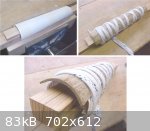
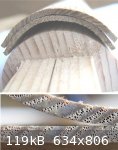
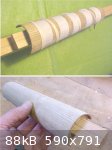
|
|
|
jdowning
Oud Junkie
    
Posts: 3485
Registered: 8-2-2006
Location: Ontario, Canada
Member Is Offline
Mood: No Mood
|
|
Now that my confusion over the rib scorch marks (or lack of) has been clarified by fledelis, it remains to run a trial to test the feasibility of
bending with the localised application of heat on the exterior surface of a rib. (Possibility #4 in my previous posting).
For this trial I shall make a wooden female mold in the same manner as the (as yet untested) lute rib mold posted on
page 2 of this thread. To facilitate fabrication, the mold will be made in two halves so that a router may be used to remove most of the waste wood -
the exact rib diameter then being produced using a small drum sander.
The heat source will be a short section (about 50 mm in length) of metal tubing or solid cylinder of the minimum inside diameter of the ribs -
rivetted to a metal shank that will fit an electric soldering iron. Basic soldering irons without thermostatic control can operate at temperatures
over 550 Celsius which is too hot. However with a small heat capacity iron it may be possible to moderate temperature levels below scorching heat
without need for an additional electrical control system.
Bending will be tested on un-marinated as well as marinated blanks.
As the mold and heating iron should take only a little time to make I should be able to fit this work in among my other projects without much delay.
|
|
|
jdowning
Oud Junkie
    
Posts: 3485
Registered: 8-2-2006
Location: Ontario, Canada
Member Is Offline
Mood: No Mood
|
|
Another bit of information that may prove useful in the quest to create fluted ribs concerns the shrinkage of hot hide glue.
On another project, some test pieces of Ash wood were coated on one face with glue size. Glue size is a dilute solution of hide glue in water - often
used in the past as a wood grain sealer. The objective of the trial was to test the effectiveness of glue size as a sealer and its compatibility with
traditional finishes such as shellac and oil varnish.
However,it is the reaction of the wood samples to application of the glue size that is of interest here.
The glue size was made to a dilution of 250 ml water to 25 ml 'Pearl' hide glue (mixed together at 140 F (60 C). This was applied at this temperature
to the wood samples on one face. As moisture was absorbed by the wood, the samples took up an almost immediate convex curvature as the wood fibres
swelled. (For one of the test samples 48 mm wide by 2 mm thick there was a dip of 2mm in the centre of the curve).
Leaving the sample to dry at room temperature and humidity (72 F @ 45%RH or 25 C @ 45% %RH) the sample 'cupped' into a concave curvature (about 1.5 mm
dip in the centre). This reverse 'cupping' was due to the shrinkage of the glue on drying.
The iconography of the 16th and 17th C often depicts lutes with a pronounced fluting of the ribs of the bowl. Perhaps the makers used glue size to
prepare the bowls for finishing?
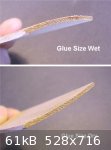
|
|
|
jdowning
Oud Junkie
    
Posts: 3485
Registered: 8-2-2006
Location: Ontario, Canada
Member Is Offline
Mood: No Mood
|
|
This morning I came across the spare black ash neck veneers - left over from the old oud project - so decided to try forming these into double curved
fluted ribs as a trial.
The veneers - about 23 cm in length and 2.2 mm thick - had been formed into a straight flute after marinating. See previous posting.
The next step is to bend the veneers into a longitudinal curve of radius about 66 cm (26 inches). This was accomplished using a wooden 'female' mold
fluted to a diameter of 33 mm and with longitudinal curve of slightly shorter radius than required.
Heat was applied using an old electric soldering iron with a copper tip of 25 mm diameter and 'rocking' the tip of the iron while applying pressure.
Gradually working along the length of the work the required curve was formed without much effort.
A soldering iron is designed to reach temperatures higher than required to hot bend wood so some scorching of the wood surface occurred. However this
scorching may easily be removed with a curved scraper and by sanding.
The finished test 'rib' has a longitudinal curve of radius 66 cm and inside diameter of 28 mm tapering to 24 mm (the neck veneer panel was tapered) -
and fluted to almost a full semi circle. This is a more extreme flute than found on the 'Dias' guitar ribs so this is very promising development and
seems to be 'the way to go'. With thinner ribs (1.5 mm) and shallower flute ,making a replica 'Dias' guitar or 'Chambure' vihuela with fluted ribs
should not be a problem (or guitars/vihuelas with even more dramatic ,deeper fluting). With a shallower flute it may also be possible to form oud or
lute ribs in this manner.
My first instrument with fluted ribs made in this fashion will be a vihuela in walnut - but that will be subject of another future project.
For some images of the fluted ribs on the 'Dias' guitar and 'Chambure' vihuela see the website of luthier Marcos Kaiser (click on 'Research') at
http://www.marcoskaiser.com

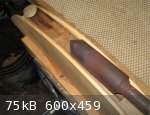
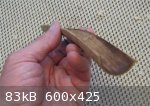
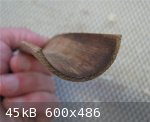
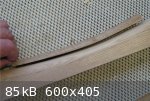
|
|
|
jdowning
Oud Junkie
    
Posts: 3485
Registered: 8-2-2006
Location: Ontario, Canada
Member Is Offline
Mood: No Mood
|
|
It is encouraging to discover that at least one luthier is currently applying my method for making fluted ribs - by marinating in 50/50
alcohol/ammonia and forming on a 'male' mold - as was posted at the start of this thread.
http://www.blogger-index.com/feed335923.html
It will be interesting to see how the instrument turns out.
The disadvantage of this method is that - although it may work well with relatively open cell woods like Ash and Walnut - tropical hardwoods like
Rosewoods, Ebony and Cocobola require application of significant heat and pressure to produce the required fluting and may not respond so readily to
softening by marinating. The other disadvantage is that working with a fixed 'male' mold reduces flexibility required for fitting the ribs - ie there
is no scope for adjustment of the rib curvature (once formed on the mold) to refine the fit.
This latest development should overcome these difficulties.
More to follow.
|
|
|
jdowning
Oud Junkie
    
Posts: 3485
Registered: 8-2-2006
Location: Ontario, Canada
Member Is Offline
Mood: No Mood
|
|
Another possibility yet to be tested in the forming of fluted ribs is the use of compression rolls to precondition blanks before hot bending.
See "Bending Ribs using Slip Rolls" on this forum.
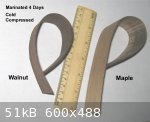
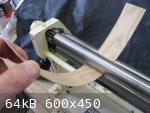
|
|
|
jdowning
Oud Junkie
    
Posts: 3485
Registered: 8-2-2006
Location: Ontario, Canada
Member Is Offline
Mood: No Mood
|
|
The Black Ash test piece - bent in 3 dimensions (ie double bent fluted) - has been cut in the centre and macro images taken of the cell structure.
History - the test piece had first been marinated in 50/50 alcohol/ ammonia mixture for 14 days, boiled in hot water for 5 minutes and then formed on
a wooden mold into a straight flute (2 dimension bent) and allowed to dry.
The fluted test piece was then hot bent longitudinally in a wooden mold to form a 3 dimensional flute - as previously described in this post.
Two test pieces were bent. The first cracked at the free end due to rushing the bending operation. It can be seen from the macro images that the early
wood cells had failed under tension at a point where the cells break through the outer surface of the wood creating a point of high stress. When
bending wood the objective - in order to avoid this kind of failure - is to keep the wood cells primarily under compression during the bending
operation.
The image taken from the centre of the test piece shows the cell compression and the formation of a relatively smooth interior surface created by the
localised higher temperatures of the hot bending operation.
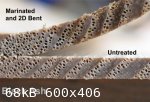
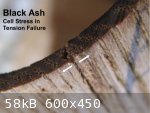
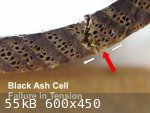
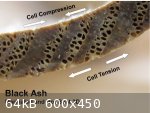
|
|
|
bulerias1981
Oud Junkie
    
Posts: 763
Registered: 4-26-2009
Location: Beacon, NY
Member Is Offline
Mood: John Vergara Luthier Lord of the Strings instrument making and repair
|
|
Not sure if anyone mentioned it, but Lebanese oud maker, Albert Mansour makes ouds with fluted ribs. Mustafa Said owns two ouds from him I believe. I
tried one Mustafa's ouds when I was in Lebanon and I noticed the weight to be super light. Albert Mansour has made ouds for Marcel Khalife also, but I
think that was in the '80s and early 90's maybe?
|
|
|
jdowning
Oud Junkie
    
Posts: 3485
Registered: 8-2-2006
Location: Ontario, Canada
Member Is Offline
Mood: No Mood
|
|
There were references at the start of this thread (page 1) to a couple of makers who have made ouds with heavily fluted ribs but it was never
confirmed in one case (Tayyar Bros. of Ottawa) if the fluting was made by hot bending or by carving. In the other case (Foad Jihad?) of Iraq the
fluting was hand carved.
If the Mansour oud was very light in weight this may imply hot bent fluting. Is there any way to confirm this - one way or the other?
I have some Ash rib stock left over from the 'Old Oud' project so have these currently marinating in 50% Ammonia/ 50% Water marinade in preparation
for a quick trial to make a fluted oud rib. Ash does bend relatively easily but - as we have seen - may easily crack across the weaker early wood
cells if forced too much in tension i.e. without sufficient application of heat needed to favour compression of the cells during bending. Tropical
hard woods with no distinct early wood/late wood cells may require greater localised heat during bending to induce compression of the wood cells but
should be less liable to cracking.
|
|
|
bulerias1981
Oud Junkie
    
Posts: 763
Registered: 4-26-2009
Location: Beacon, NY
Member Is Offline
Mood: John Vergara Luthier Lord of the Strings instrument making and repair
|
|
Mustafa is the blind prodigy. And he specifically wanted an oud that was VERY light as to have less to worry about. I was at his place in Lebanon and
tried it myself. Certainly it was very light like the oud I made with 1.5mm ribs. I'm sure it was bent and not carved. I don't know if this is a
regular feature of Albert Mansour ouds, or if it was simply a custom request by Mustafa Said. I did notice the joints between ribs was thicker as to
make a stronger joint.
|
|
|
jdowning
Oud Junkie
    
Posts: 3485
Registered: 8-2-2006
Location: Ontario, Canada
Member Is Offline
Mood: No Mood
|
|
Thanks for the information bulerias1981.
I assume that the rib fluting was significant and not just the shallow fluting that occurs naturally to some extent on thin lute ribs? This being the
case then this is further encouragement to continue with next planned set of preliminary tests that should be completed within the next week.
With a hot bent fluted rib, one challenge may also be to make a perfect joint between the ribs. One thought is that this problem might be simplified
by first joining and gluing the ribs closely (but not perfectly) and then carefully cutting with a saw or file - along the rib joint - to form a
groove wide enough to accept a perfect fitting purfling or line strip. This procedure would be undertaken after assembling the bowl and after gluing
the joint reinforcing strips inside the bowl.
I have tried this technique successfully on one of my lutes and it does work but is quite time consuming compared to joining the ribs together with
the inter-rib purfling in the conventional manner.
|
|
|
bulerias1981
Oud Junkie
    
Posts: 763
Registered: 4-26-2009
Location: Beacon, NY
Member Is Offline
Mood: John Vergara Luthier Lord of the Strings instrument making and repair
|
|
Certainly it was intended. The oud(s) were made within the last few years. Maybe other people here know more about the maker.
|
|
|
jdowning
Oud Junkie
    
Posts: 3485
Registered: 8-2-2006
Location: Ontario, Canada
Member Is Offline
Mood: No Mood
|
|
Tha Black Ash sample ribs have been marinating in 50% Ammonia/ 50% water for 4 days so it is time to try to bend some oud ribs - using the female mold
described in page 2 of this thread and the hot soldering iron.
It is useless to try to hot bend the freshly marinated wood - it is too soft and flexible so merely buckles and 'kinks' under the pressure as bending
proceeds.
Bending has, therefore, been tested in 2 stages - the first to bend each rib sample into a straight flute on a wooden mold - allow to dry - and then
try to hot bend the longitudinal curve.
The straight mold is 25 mm in diameter. The first sample was heated with a hot air gun to evaporate all of the marinating fluid from the surface, then
quickly tied to the mold (while still hot) with flat boot laces and allowed to dry overnight. The flat boot laces have some elasticity so can draw the
rib sample to the contour of the mold quite uniformly without too much pressure. The hot air gun has been used in place of boiling the sample in water
- just for convenience.
The rib samples are roughly rib shaped (tapered at both ends) about 2 mm thick, 500 mm long and about 33 mm maximum width.
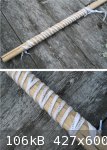
|
|
|
jdowning
Oud Junkie
    
Posts: 3485
Registered: 8-2-2006
Location: Ontario, Canada
Member Is Offline
Mood: No Mood
|
|
After drying on the mold the straight fluted rib when removed has shrunk in diameter and taken up a slight longitudinal curve. The diameter at this
stage is about 22 mm.
The wood shows signs at the edges of compression by the bootlaces due to the initial softness of the marinated wood before drying.
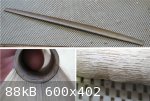
|
|
|
jdowning
Oud Junkie
    
Posts: 3485
Registered: 8-2-2006
Location: Ontario, Canada
Member Is Offline
Mood: No Mood
|
|
The mold used for the bending trials represents a small bowl length of about 40 cm so the test is quite severe.
The soldering iron temperature was better controlled using a standard lighting 'dimmer' switch. This helped to avoid wood 'charring' during
bending.
Using the hot iron to force the straight fluted rib into the curvature of the mold was only partially successful - achieving a minimum longitudinal
curvature of about 280 mm radius (11 inches) with a flute diameter of about 35 mm (1.4 inches).
The limiting condition was premature failure of the wood cells in compression. This was caused by grooves in the wood surface (the convex underside of
the rib) due to pressure of the boot lace ties used to clamp the straight fluted rib to the mold. Elimination of this problem could assist in forming
even tighter longitudinal rib curvatures.

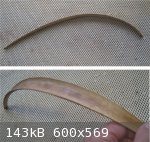
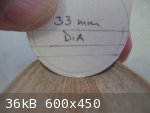

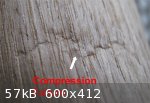
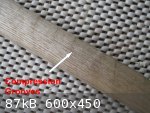
|
|
|
| Pages:
1
..
3
4
5 |